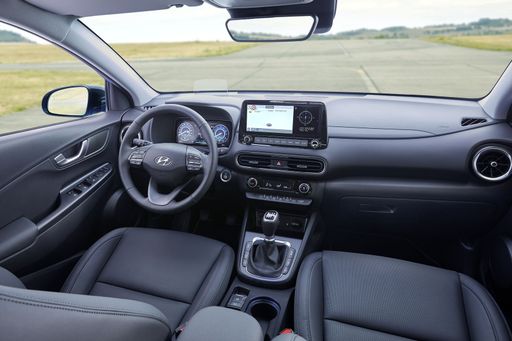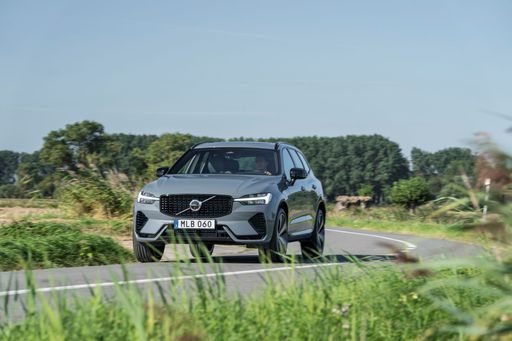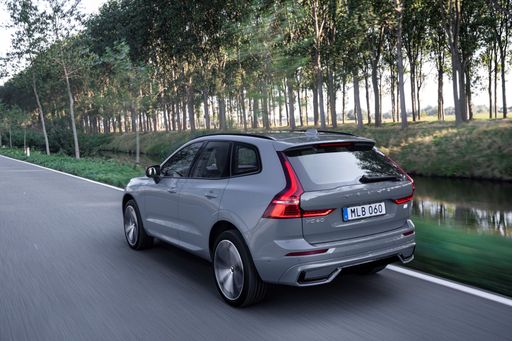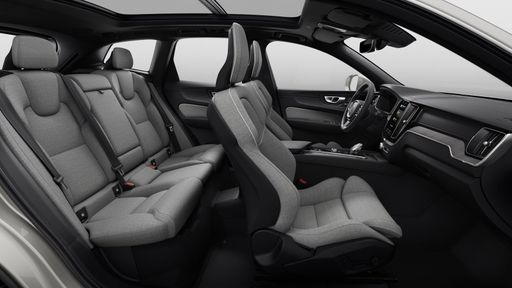Hyundai Kona vs Volvo XC60 – Differences & prices compared
Compare performance, boot space, consumption and price in one view.
Find out now: which car is the better choice for you – Hyundai Kona or Volvo XC60?
The Hyundai Kona (SUV) comes with a Electric, Petrol or Full Hybrid engine and Automatic or Manuel transmission. In comparison, the Volvo XC60 (SUV) features a Petrol MHEV or Plugin Hybrid engine with Automatic transmission.
When it comes to boot capacity, the Hyundai Kona offers 466 L, while the Volvo XC60 provides 483 L – depending on how much space you need. If you’re looking for more power, decide whether the 218 HP of the Hyundai Kona or the 455 HP of the Volvo XC60 suits your needs better.
In terms of consumption, the values are 14.60 kWh4.60 L per 100 km for the Hyundai Kona, and 2.80 L for the Volvo XC60.
Price-wise, the Hyundai Kona starts at 23100 £, while the Volvo XC60 is available from 49200 £. Compare all the details and find out which model fits your lifestyle best!
Hyundai Kona
The Hyundai Kona blends a bold design with a versatile interior, making it a standout choice in the compact SUV market. Its crisp handling and responsive steering provide an engaging driving experience, whether in the city or on the open road. The vehicle also offers a range of features designed to enhance comfort and connectivity, ensuring a pleasurable journey for both driver and passengers.
details @ hyundai.news
@ hyundai.news
 @ hyundai.news
@ hyundai.news
 @ hyundai.news
@ hyundai.news
 @ hyundai.news
@ hyundai.news
Volvo XC60
The Volvo XC60 strikes a perfect balance between contemporary design and practical functionality, making it an appealing choice for those in search of a reliable and stylish SUV. Its interior showcases a blend of high-quality materials and innovative technology, ensuring a comfortable and seamless driving experience. With its emphasis on safety and environmental sustainability, the XC60 continues to stand out in the competitive SUV market.
details @ media.volvocars.com
@ media.volvocars.com
 @ media.volvocars.com
@ media.volvocars.com
 @ media.volvocars.com
@ media.volvocars.com
 @ media.volvocars.com
@ media.volvocars.com
 @ media.volvocars.com
@ media.volvocars.com

|

|
|
|
|
Costs and Consumption |
|
|---|---|
|
Price
23100 - 41600 £
|
Price
49200 - 75100 £
|
|
Consumption L/100km
4.6 - 7 L
|
Consumption L/100km
2.8 - 7.4 L
|
|
Consumption kWh/100km
14.6 - 16.8 kWh
|
Consumption kWh/100km
-
|
|
Electric Range
377 - 514 km
|
Electric Range
74 - 82 km
|
|
Battery Capacity
1.3 - 65.4 kWh
|
Battery Capacity
14.70 kWh
|
|
co2
0 - 163 g/km
|
co2
64 - 169 g/km
|
|
Fuel tank capacity
38 - 47 L
|
Fuel tank capacity
71 L
|
Dimensions and Body |
|
|---|---|
|
Body Type
SUV
|
Body Type
SUV
|
|
Seats
5
|
Seats
5
|
|
Doors
5
|
Doors
5
|
|
Curb weight
1370 - 1773 kg
|
Curb weight
1900 - 2150 kg
|
|
Trunk capacity
466 L
|
Trunk capacity
468 - 483 L
|
|
Length
4350 - 4385 mm
|
Length
4688 - 4708 mm
|
|
Width
1825 mm
|
Width
1902 mm
|
|
Height
1580 - 1585 mm
|
Height
1651 - 1658 mm
|
|
Payload
420 - 490 kg
|
Payload
510 - 550 kg
|
Engine and Performance |
|
|---|---|
|
Engine Type
Electric, Petrol, Full Hybrid
|
Engine Type
Petrol MHEV, Plugin Hybrid
|
|
Transmission
Automatic, Manuel
|
Transmission
Automatic
|
|
Transmission Detail
Manual Gearbox, Dual-Clutch Automatic
|
Transmission Detail
Automatic Gearbox
|
|
Drive Type
Front-Wheel Drive, All-Wheel Drive
|
Drive Type
All-Wheel Drive
|
|
Power HP
115 - 218 HP
|
Power HP
250 - 455 HP
|
|
Acceleration 0-100km/h
7.8 - 11.9 s
|
Acceleration 0-100km/h
4.9 - 6.9 s
|
|
Max Speed
162 - 210 km/h
|
Max Speed
180 km/h
|
|
Torque
200 - 265 Nm
|
Torque
350 - 709 Nm
|
|
Number of Cylinders
3 - 4
|
Number of Cylinders
4
|
|
Power kW
85 - 160 kW
|
Power kW
184 - 335 kW
|
|
Engine capacity
998 - 1598 cm3
|
Engine capacity
1969 cm3
|
General |
|
|---|---|
|
Model Year
2024 - 2025
|
Model Year
2025
|
|
CO2 Efficiency Class
A, D, C, E, F
|
CO2 Efficiency Class
F, B
|
|
Brand
Hyundai
|
Brand
Volvo
|
Hyundai Kona
The Hyundai Kona: A Comprehensive Overview
The Hyundai Kona has established itself as a standout in the compact SUV segment, blending innovation with performance and style. As the automotive world moves towards more sustainable and efficient options, the Kona offers a variety of powertrains, from traditional petrol engines to full hybrids and all-electric models.
Powertrain Options and Performance
The Hyundai Kona's powertrain choices cater to a wide range of preferences. For petrol enthusiasts, the Kona offers a 1.0L T-GDI engine, delivering 100 PS, and a more robust 1.6L T-GDI variant with up to 170 PS. Those looking for efficiency without sacrificing power can consider the full hybrid model, offering 129 PS and an impressive consumption of 4.5 L/100km.
For a greener option, the all-electric Kona provides a compelling case. With battery capacities of up to 65.4 kWh, the electric Kona offers power outputs of 156 to 218 PS, and efficiencies as low as 14.6 kWh/100km, enabling an electric range of up to 513 km.
Technical Specifications and Innovations
Built on a robust platform, the Kona delivers versatility and reliability. With a choice between manual or dual-clutch automatic gearboxes, along with options for front-wheel or all-wheel drive, the Kona ensures a tailored driving experience. The handling is enhanced by the car's lightweight construction, balancing a 1370 to 1773 kg curb weight with dynamic performance.
The Kona's design doesn't compromise cargo space for style; it offers a generous 466 L boot capacity. With a relatively compact body, measuring 4350 to 4385 mm in length, the Kona easily navigates urban environments while still commanding a strong road presence with its 1825 mm width.
Efficiency and Eco-Friendliness
Hyundai is committed to reducing emissions, as evidenced by the Kona's CO2 efficiency ratings, which range from class A for electric models to class D for some higher-performance petrol variants. The focus on reducing environmental impact without sacrificing driving pleasure is notable throughout the Kona range.
Costing and Value
The Hyundai Kona offers commendable value for money. Pricing starts at €26,400 and reaches up to €50,690, depending on the chosen configuration. The monthly running costs range from €956 to €1090, with a cost per kilometre of 38.3 to 43.6 cents, making it a competitive option in its class.
Conclusion: Modern, Efficient, and Versatile
The Hyundai Kona stands as a testament to Hyundai's commitment to innovation, efficiency, and practicality. Whether you are inclined towards a traditional combustion engine, a hybrid for a balance of power and efficiency, or a full electric model for maximum eco-friendliness, the Kona provides a tailored solution for each unique driver preference.
Volvo XC60
Introduction to the Volvo XC60
The Volvo XC60 continues to set the standard in the luxury SUV category, embodying a blend of Scandinavian design, cutting-edge technology, and robust performance. As one of Volvo's best-selling models, the XC60 delivers an exceptional driving experience characterized by its impressive powertrains and a suite of innovative features. This article delves into the technical intricacies and innovative advancements that define the Volvo XC60, highlighting why it remains a top choice for discerning drivers.
Performance and Powertrains
The Volvo XC60 offers a range of powertrains to suit diverse preferences, from the efficient mild-hybrid systems to the powerful plug-in hybrids. The mild-hybrid variants provide a balance of performance and fuel economy, generating up to 250 PS and achieving fuel consumption as low as 7.7 L/100km. Meanwhile, the plug-in hybrid models take efficiency to another level, offering up to 455 PS with remarkably low fuel consumption of just 0.9 L/100km and an electric range of up to 80 km.
Electric Innovation
Volvo’s commitment to sustainability is evident in the XC60's plug-in hybrid models, which offer a battery capacity of 14.7 kWh. This allows for significant electric-only driving, reducing emissions and providing a quieter ride. With a focus on reducing its carbon footprint, Volvo offers some versions with CO2 emissions as low as 22 g/km. The renowned Polestar Engineered package further enhances the driving dynamics, featuring sport-tuned suspension and increased power output.
Advanced Safety Features
Known for prioritising safety, Volvo integrates several advanced safety technologies into the XC60. Standard features include the City Safety suite, which incorporates collision avoidance and mitigation, along with pedestrian detection. The SUV is also equipped with Volvo's Pilot Assist system, an advanced driver assistance feature that aids steering, braking, and acceleration up to 130 km/h, ensuring a more relaxed drive on highways.
Interior Comfort and Technology
The XC60 doesn’t compromise on luxury, offering a spacious interior with high-quality materials and state-of-the-art technology. The standard Sensus infotainment system provides intuitive control over multimedia, navigation, and connected services. Features such as a panoramic sunroof and premium audio systems enhance comfort and driving pleasure, while the adaptive seats and climate control ensure a comfortable environment for all passengers.
Conclusion
The Volvo XC60 exemplifies a harmonious blend of style, technology, and sustainability. With its array of powertrains and cutting-edge features, it meets the needs of a broad range of drivers, maintaining Volvo’s reputation for safety and quality. Whether one opts for the fuel-efficient mild-hybrid or the powerful plug-in hybrid, the XC60 remains a formidable contender in the luxury SUV market, offering a driving experience that is both indulgent and responsible.
What drive types are available for the Hyundai Kona?
Available configurations include Front-Wheel Drive or All-Wheel Drive.
The prices and data displayed are estimates based on German list prices and may vary by country. This information is not legally binding.
